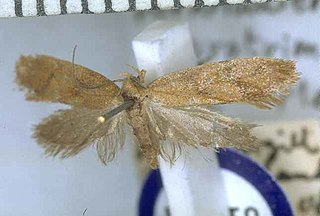Haplovalva is a monotypic moth genus in the family Gelechiidae erected by Anthonie Johannes Theodorus Janse in 1958. Its only species, Haplovalva ametris, was first described by Edward Meyrick in 1921. It is found in South Africa.
Brachmia inspersa is a moth in the family Gelechiidae. It was described by Edward Meyrick in 1921. It is found in Assam, India.
Dichomeris baccata is a moth in the family Gelechiidae. It was described by Edward Meyrick in 1923. It is found in Amazonas, Brazil.
Dichomeris introspiciens is a moth in the family Gelechiidae. It was described by Edward Meyrick in 1926. It is found in South Africa, where it has been recorded from KwaZulu-Natal.
Dichomeris pladarota is a moth in the family Gelechiidae. It was described by Edward Meyrick in 1921. It is found in Zimbabwe.

Dichomeris crambaleas is a moth in the family Gelechiidae. It was described by Edward Meyrick in 1913. It is found in Taiwan and Assam, India.
Dichomeris finitima is a moth in the family Gelechiidae. It was described by Edward Meyrick in 1921. It is found in Zimbabwe.
Dichomeris turgida is a moth in the family Gelechiidae. It was described by Edward Meyrick in 1918. It is found in South Africa.
Dichomeris malachias is a moth in the family Gelechiidae. It was described by Edward Meyrick in 1913. It is found in Assam, India.
Dichomeris coenulenta is a moth in the family Gelechiidae. It was described by Edward Meyrick in 1927. It is found in Zimbabwe.
Dichomeris oenombra is a moth in the family Gelechiidae. It was described by Edward Meyrick in 1914. It is found in Malawi and South Africa.
Dichomeris heteracma is a moth in the family Gelechiidae. It was described by Edward Meyrick in 1923. It is found in Peru and Amazonas, Brazil.
Dichomeris percnacma is a moth in the family Gelechiidae. It was described by Edward Meyrick in 1923. It is found in Peru and Amazonas, Brazil.
Dichomeris praevacua is a moth in the family Gelechiidae. It was described by Edward Meyrick in 1922. It is found in Shanghai, China.
Dichomeris seminata is a moth in the family Gelechiidae. It was described by Edward Meyrick in 1922. It is found on the Seychelles, where it has been recorded from Aldabra.
Helcystogramma meconitis is a moth in the family Gelechiidae. It was described by Edward Meyrick in 1913. It is found in Argentina.
Scrobipalpa chersophila is a moth in the family Gelechiidae. It was described by Edward Meyrick in 1909. It is found in South Africa.
Photodotis spilodoma is a moth of the family Gelechiidae. It was described by Edward Meyrick in 1918. It is found in South Africa.
Parallactis plaesiodes is a moth in the family Autostichidae. It was described by Edward Meyrick in 1920. It is found in Kenya, Mozambique and South Africa.

Tingena paratrimma is a species of moth in the family Oecophoridae. It is endemic to New Zealand and has been observed in the lower parts of the South Island. George Hudson regarded this species are uncommon. The adults of this species are on the wing from November to February.

